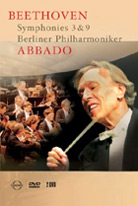May 2004
 You could be pardoned for wondering why we need another cycle of
Beethoven’s symphonies. It seems every conductor ever to raise a baton has done the
cycle at least once. Of course, the obvious difference is this is on DVD, where EuroArts
has only one competitor -- Karajan on Sony. Abbado became artistic director of the Berlin
Philharmonic shortly after Karajan’s death in 1989, and there are many differences
between the way the two conductors approached this music. Karajan’s were recorded in
the early ‘80s in stereo, and Karajan, though steering more toward a classical
approach, was still a romantic at heart. He was also 74 years old and intent on leaving a
video record of his legacy. You could be pardoned for wondering why we need another cycle of
Beethoven’s symphonies. It seems every conductor ever to raise a baton has done the
cycle at least once. Of course, the obvious difference is this is on DVD, where EuroArts
has only one competitor -- Karajan on Sony. Abbado became artistic director of the Berlin
Philharmonic shortly after Karajan’s death in 1989, and there are many differences
between the way the two conductors approached this music. Karajan’s were recorded in
the early ‘80s in stereo, and Karajan, though steering more toward a classical
approach, was still a romantic at heart. He was also 74 years old and intent on leaving a
video record of his legacy.
Abbado at 68 looks and sounds vital. At the time of these tapings (2000-2001), the Berlin Philharmonic had worked with him for 11 years and the orchestra and conductor knew each other well. Abbado also had the good fortune to have an excellent film director, a full complement of inconspicuous camera operators and the availability of Dolby Digital and DTS engineers. Like many conductors, Abbado has changed from a fiery conductor in his youth, capable of shaking the foundations of any concert hall, to a more introspective and thoughtful artist. Classicism over romanticism. Given that Beethoven straddled the two periods, a good case could be made for starting classical and switching to a more romantic view from the Third Symphony on. Abbado instead mixes and matches, sometimes going from one interpretive style to another. In the Ninth Symphony, for instance, Abbado takes the second movement briskly but also very lightly -- Haydn instead of Mahler. By the final choral movement, he seems intent on rattling the walls and pulls the final pages to a goosebump-inducing conclusion worthy of Bernstein. In the Sixth, especially in the storm movement, Abbado again brings incredible excitement. Yet in the Eighth, his third movement sounds like a late classical piece. Abbado has been quoted as saying that "Beethoven should sound neither like Haydn nor Wagner.... He should sound like Beethoven." All these performances show a considered approach that makes you believe Abbado spent many serious hours grappling with how to make Beethoven sound like Beethoven. Luckily, the Berlin Philharmonic plays with professionalism and heart throughout, allowing Abbado the luxury of bringing any interpretive vision he might have to brilliant life. Technically, the DVDs have a very good picture given their genesis as a PAL television show. The camera work is busy, but it does a wonderful job of showing us the important players at the right times. The sound is multi-mic all the way through, so any sense of a delicate soundstage is gone. Otherwise, the sound is very clear and robust. Both surround mixes use the rear channels for ambience and applause only. The DTS version has better bass response, but the sound is a bit brittle, while the Dolby Digital track has a more natural sound. Fans of Abbado will be happy to see a multi-angle feature where they can watch the either the TV-director’s version or they can watch the conductor, much as the musicians would. This is the best set of the Beethoven symphonies you can currently buy on DVD. GO BACK TO: |
 Beethoven - Complete
Symphonies
Beethoven - Complete
Symphonies